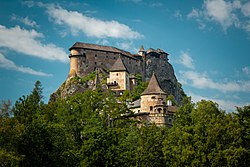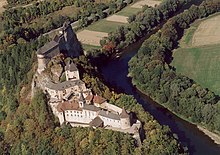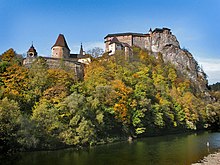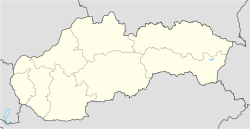Orava Castle
This article needs additional citations for verification. (August 2015) |
| Orava Castle | |
|---|---|
Oravský hrad | |
| Oravský Podzámok Slovakia | |
 Orava Castle in August 2020 | |
| Type | Castle |
| Site information | |
| Owner | Slovakia |
| Controlled by | Kingdom of Hungary, Slovakia |
| Open to the public | Yes |
| Site history | |
| Built | 13th–17th century |
Orava Castle (
Orava Castle stands on the site of an old wooden fortification, built after the
The mining magnate Thurzo family, who took charge in the mid-16th century, were responsible for a great deal of rebuilding work, although its present form was not finalised until 1611. It burned down again in 1800, after which it was no longer used as a residence. After a period of dilapidation dating until World War II, the castle became a national monument.
Origins


The natural rock formation known as "castle cliff" – a limy spur 112 meters (367 ft) high, surrounded by the river Orava and its right tributary stream Račová – has been inhabited since primeval times. During its history a wooden rampart became a strong walled castle of which the first written record dates back to 1267. At that time only the ground floor was built of stone, while the upper floors were made of wood.
In 1370 as part of the
16th–18th centuries

After the death of John of Dubovec, his heirs quarreled over the inheritance and the situation became so bad that the castle even became a store-house. It was paid for by the mine owner Ferenc Thurzó. A lot of building activity took place at the castle following this time period. The wooden stairs in the Upper Castle were replaced by stone stairs. The same was done to the stairs between the Middle and the Upper Castle with the drawbridge. A cellar was also dug out of the stone of the castle court and a single-story residence-wing was built in the lower castle near the west wall.
György Thurzó also carried out some important repairs. One of the first was the building of a tunnel between both castle gates, above which was formed a large terrace. After this was all done he moved the living-quarters and the building of the chapel started using parts of some old architecture. The interior furnishing of the chapel was later arranged in a taste which suited the new owners of the castle. One of the most well-known features is the Renaissance grave tomb of György Thurzó from the beginning of the 17th century and the Baroque altar from 1751–1752.
Disuse, fire and the museum

After the death of Erzsébet Czobor, the widow of György Thurzó, the castle became the property of Thurzó's daughters, who entrusted its administration to an elected administrator. Because of changes in politics, society and the economy, the castle gradually lost its important functions. Only a few clerks stayed on and the uninhabited and disused parts of the castle gradually deteriorated. The greatest catastrophe affected the castle in 1800, when a gigantic fire destroyed all the wooden parts of the castle. Some objects from the Lower Castle were recovered after the fire because they had been covered by the roof shingles. However, the objects from the Middle and Upper Castle were not reconstructed until 1861.
To find a use for the historical object,
Cultural references
Many scenes of the 1922 film
References
- ^ a b Votruba, Martin. "Nosferatu (1922) Slovak Locations". Slovak Studies Program. University of Pittsburgh.
- ^ Mark Gatiss (3 January 2020). In Search of Dracula with Mark Gatiss. BBC Two.
- ^ a b "Filmography". Slovak Film Commission. Retrieved July 18, 2021.
- ^ Badowski, Adam. The Witcher Artbook. p. 16.
- ^ "RTVS News report". YouTube. Archived from the original on 2021-12-22. Retrieved July 18, 2021.
External links
- Official website

- Orava Castle from Slovak Heritage
- Orava Castle Tour Information from Muzeum.sk
- Photographs of Orava Castle from Muzeum.sk
- Christmas at Orava Castle
- http://www.oravskyhrad.sk/
- Paper model of Orava Castle
- Drone video of Orava Castle
- Slovak Spectator - Orava Castle: Dracula's Slovak residence

